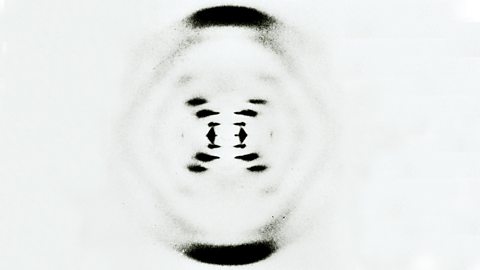The structure of DNA
DNA
DNA molecules are large and complex. They carry the genetic code that determines the characteristics of a living organism.
Genes
A gene is a section of DNA that codes for a specific protein. It is the unit of heredityGenetic information that determines an organism's characteristics, passed on from one generation to another. To do with passing genes to an offspring from its parent or parents., and may be copied and passed on to the next generation.
Chromosomes
The nucleusThe nucleus controls what happens inside the cell. Chromosomes are structures found in the nucleus of most cells. The plural of nucleus is nuclei. of the cell contains chromosomeThe structure made of DNA that codes for all the characteristics of an organism.. These are long threads of DNA, each made up of many genes.
The diagram shows the relationship between the cell, its nucleus, the chromosomes in the nucleus, and genes.
James Watson and Francis Crick worked out the structure of DNADeoxyribonucleic acid. The material inside the nucleus of cells, carrying the genetic information of a living being. in 1953. By using data from other scientists, they were able to build a model of DNA. The X-ray data they used showed that DNA consists of two strands coiled into a double helixThe shape of the DNA molecule, with two strands twisted together in a spiral. .


Base pairs
The вҖҳbackboneвҖҷ of each DNA strand is made from alternating sugar and phosphate molecules with paired chemicals between each strand called bases. Note that these are different to bases in relation to acids and alkalis in chemistry. There are four different bases in DNA:
- thymine, T
- adenine, A
- guanine, G
- cytosine, C
There are chemical bonds between the two strands in DNA, formed by pairs of bases. They always pair up in a particular way, called complementary base pairing:
- thymine pairs with adenine (TвҖ“A)
- guanine pairs with cytosine (GвҖ“C)
The order that these bases are found in the genes determines the order of the amino acids they code for. Each gene has a particular order of bases in the DNA, and this leads to a particular order of amino acids which create a specific protein.
Although many characteristics are controlled by multiple genes, some characteristics are controlled by a single gene, eg fur in animals, and red-green colour blindness in humans. Each gene might have different forms, and these are called alleles.
Example
The gene for eye colour has an allele for blue eye colour and an allele for brown eye colour. For any gene, a person may have the same two alleles or two different ones.
Triplet code - Higher tier only
The sequence of every amino acid in a protein is determined by the triplet code, which is a code of three bases. Therefore each specific amino acid will have a triplet code of different bases.
More guides on this topic
- Classification and biodiversity вҖ“ WJEC
- Cell division and stem cells вҖ“ WJEC
- Variation вҖ“ WJEC
- Mutation вҖ“ WJEC
- Evolution вҖ“ WJEC
- The nervous system вҖ“ WJEC
- Homeostasis вҖ“ WJEC
- The role of the kidneys in homeostasis вҖ“ WJEC
- Micro-organisms and their applications вҖ“ WJEC
- Disease, defence and treatment вҖ“ WJEC
- Video playlist